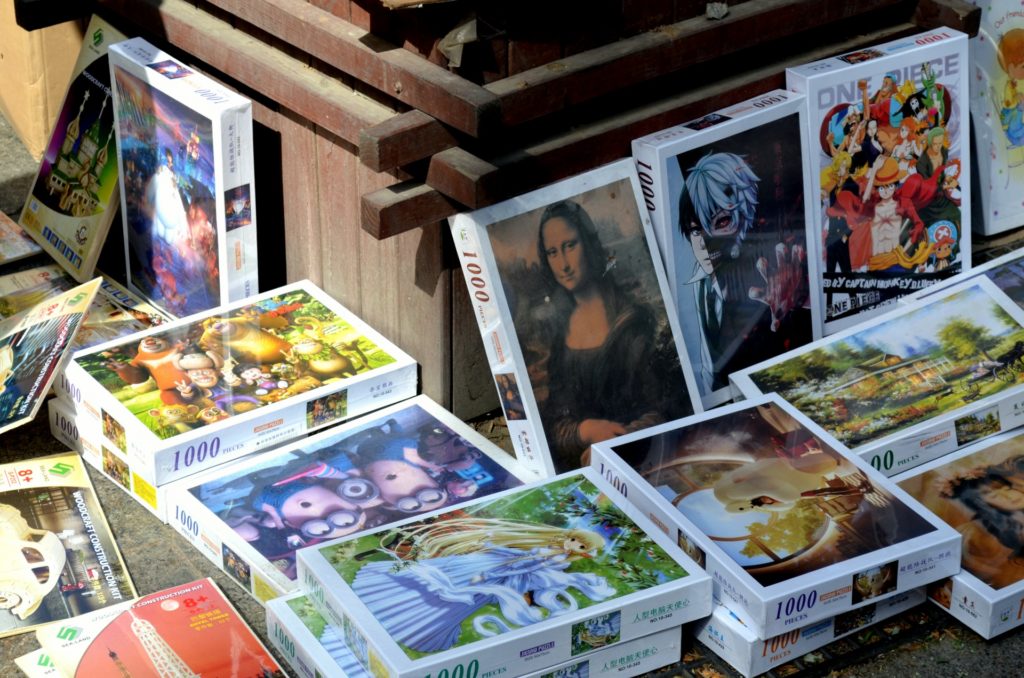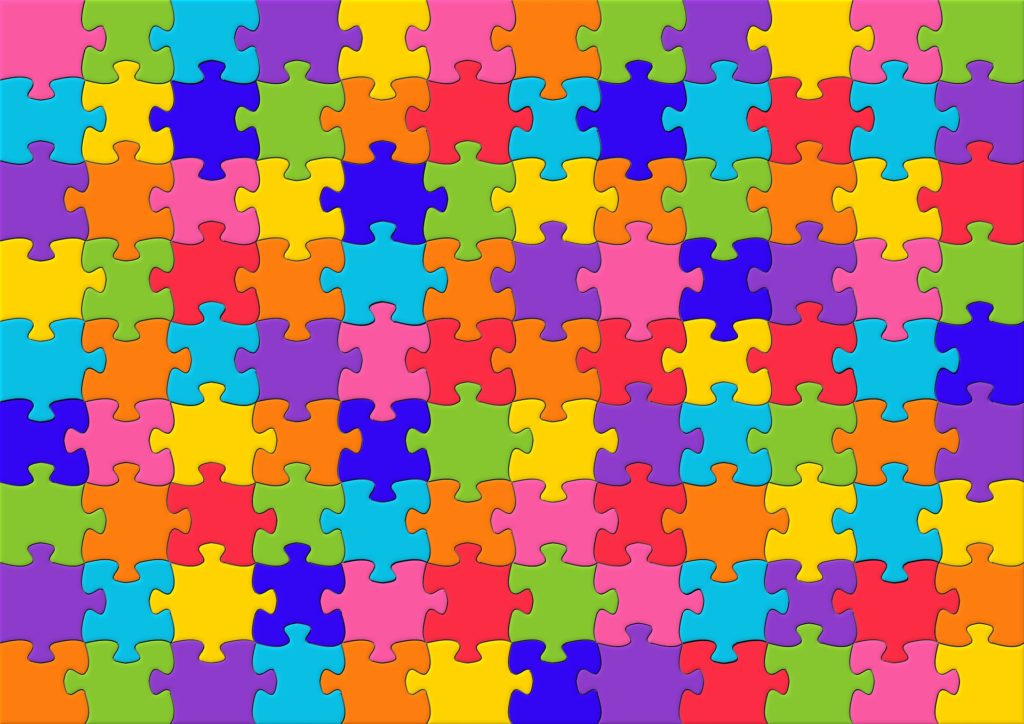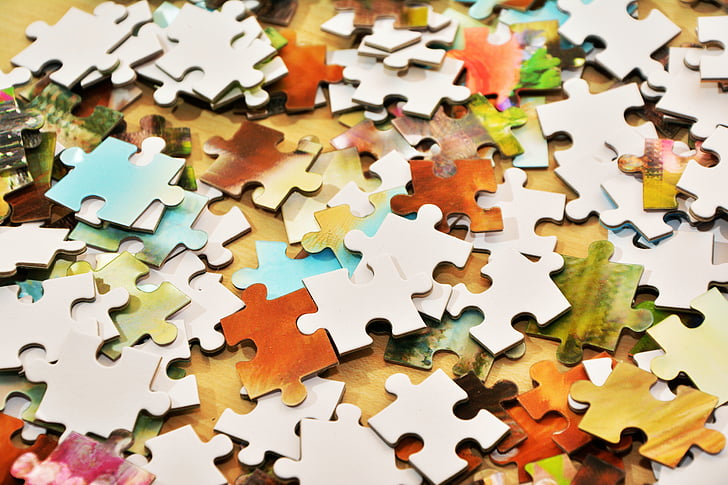Maybe it’s that pandemic pent-upness that has caused a spike in puzzle activity around the world. After all, puzzles have been an age-old amusement. I wonder what the crossword equivalent was for our Cro-magnon cousins?
If I asked you to name another commodity, besides toilet paper and hand sanitizer, that was rare during these pandemic times, what would you guess? I’ll bet you wouldn’t guess jigsaw puzzles! Apparently though, you can add jigsaw puzzles to the list of precious items.
Not being a puzzler myself, I hadn’t a clue. Growing up, a friend’s mother was always working on a puzzle. When they were done she would glue them together, frame them, and hang them in her sewing room. I loved to look at the ones of famous icons around the world, like the Eiffel Tower, the Statue of Liberty, and a famous temple in Kyoto, Japan.
I actually think that puzzles of these famous places around the world started my fascination with travel and geography.
But that was then and I had no idea jigsaw puzzles, and puzzles of all sorts really, were still so popular.

Image: Public Domain/Pictures.net
The History Of Puzzles
The Puzzle Museum in Atlanta published a brief history of puzzles, pointing out that riddles were the first version of puzzles. We find them in Greek mythology (the Riddle of the Sphinx, for example), in Homer’s classic tales, and even in the Bible.
Throughout history, puzzles have combined words with graphics, resulting in acrostics and anagrams. The concept of a rebus was seen as early as the Middle Ages. This is when letters, pictures, or symbols stand for particular words and phrases. An example from history is a family crest. A modern example is the term “IOU” for “I owe you”.
Another form of early puzzle is a magic word or magic number square. Words or numbers were thought to have magical properties and were used to ward away evil. In the Renaissance astrologers believed that magic number squares could guard against melancholy.
The Puzzle Museum also documents mechanical puzzles—puzzles with moving parts. A “dissection puzzle” is an example. The tangram is a dissection puzzle originating in China (dating back as early as 4,000 years ago), which is made of seven polygons that fit together to form particular patterns. Versions of the tangram became popular in the 1800s throughout Europe and America. Puzzle catalogues were published in Britain as early as the 1800s—showing that for at least a couple of hundred years there has been a growing demand for puzzles of all kinds.
But why is that?
Puzzles and Your Brain
I’ll answer with a question: What is yours, yet others use more than you do?
As you ponder this question, a couple of things are happening in your brain.
First, your brain synapses are searching for familiar ideas or connections.
Second, you are relaxing into a sort of artificial problem solving situation: everything is under control. It takes off the stress of having to solve a “real” problem (but you’re still getting the practice of coming up with a solution).
To solve a puzzle, a person must be able to connect information in one’s memory with “hidden” information in a puzzle. This connection helps us put together innovative ideas. As one psychology researcher put it, solving puzzles requires a combination of memory and imaginative association. This insight helps us see the puzzle’s hidden twist or secret meaning.
Another psychologist suggests the benefits and satisfaction of solving puzzles. Wagner points out that many (if not most) of life’s problems are a challenge to manage or solve, so “there’s something lovely about the contained problems presented by puzzles”. She points out that puzzles force us to focus our attention in one place. They serve a sort of mindfulness practice, drawing the brain into a space that is contained and safe.
Wagner also reminds us that puzzles give our brains rules to follow, and they have a clear end-point. In that sense, when we work out a puzzle, we’re practicing solving real-world problems. These “real” problems, of course, are usually not so clear and neat to tie up. “Puzzles take all the ambiguity out of the solution-finding process, letting the brain enjoy just what’s in front of it, and no more,” Wagner writes. And this strengthens our mental processes for when we do have to find a solution to a problem.
The answer to the riddle, by the way, is: your name.
Consider how this problem-solving phenomenon works as we engage with some of our favorite pandemic pastimes: puzzles.
What’s So Fascinating About Jigsaw Puzzles?
We love jigsaw puzzles today! Perhaps you have passed a pleasant hour (or two) piecing together the jagged border of a table-sized depiction of Frieda Kahlo’s face, or the coast of Ireland, or a platter of sushi… So satisfying!
But did you know that jigsaw puzzles were originally developed as a tool to teach children geography?
Back in 1760, John Spilsbury, an English cartographer, created an early prototype of the jigsaw puzzle by cutting apart the countries on a map of Europe. Spilsbury perfected the process (sticking maps to hardwood and cutting them apart with a fine instrument called a marquetry saw) and created puzzle/maps of the UK (England, Scotland, Wales and Ireland); Africa, Asia, and America. The more educated and affluent citizens of Britain enjoyed these early puzzles (including the royal family).
Of course they would not be called “jigsaw puzzles” for another hundred years or so. I went down an internet rabbit hole to check on this fact, and learned that the earliest patent for a jig saw was in 1857.
Jigsaw Puzzle Improvements Over The Years
The look and feel of jigsaw puzzles continued to improve. Three particular innovations came with the Industrial Revolution (19th and 20th centuries).
- With more sophisticated printing techniques, lithographers made
higher quality images. - The invention of the treadle saw (powered by foot peddle) also made it possible to quickly churn out more detailed and intricate interlocking puzzle pieces.
- Instead of hardwood, puzzle manufacturers began to use plywood. It was easier to cut, and lighter as well.
With greater production of puzzles, more people had access and the addiction hobby spread.
By the early 1900s, jigsaw puzzles had caught on in the U.S. Those early puzzles were different than what we know today. Pieces were cut on the color lines, and in fact transition pieces bleeding together several colors didn’t yet exist. On top of these challenges, pieces didn’t interlock. Can you imagine a jigsaw puzzle where the pieces don’t interlock?
By the early 1900s, the company Pastime puzzles perfected the interlocking puzzle piece. Parker Brothers was another big name you will recognize; they got into the puzzle business in 1907.
During the Depression in the U.S., puzzles became increasingly popular.
Financial constraints led manufacturers to develop much cheaper means of production using cardboard and die-cutting technology (which was brand new in the 1930s). Jigsaw puzzles were so cheap to make and produce using these new techniques that families could afford to buy them—and, handily, they were reusable.
Today the jigsaw puzzle production technique is even more high tech. Some manufacturers use steel blades to cut apart intricate pieces, and laser cutting also improves the process. This makes possible production of increasingly innovative puzzles.
Jigsaw Puzzle Popularity During Coronavirus
Puzzle makers around the country haven’t been able to keep up with the increased demand for jigsaw puzzles. Their popularity makes sense when you think about it. Everyone is looking for a little “piece” and quiet!
For many, piecing together jigsaw puzzles is a way to occupy spare time. It requires attention to detail and focus; it’s distracting and relaxing. And those are qualities we appreciate right about now.
Just How Popular Are Jigsaw Puzzles?
In fact, jigsaw puzzle sales are reported up by more than 300%. As a result, many jigsaw puzzle producers have sold out of inventory Adding to the supply chain issue, manufacturing has shut down (puzzle making is not considered an essential business). For producers who still have puzzles in stock, they’re dealing with safety and social distancing concerns in their warehouses.

Courtesy Pixabay
Puzzle makers have a suggestion for puzzle lovers who still have a supply on their game shelf or in their closet. Take them out! This would be a good time to take on a challenging puzzle without buying a new one. A Facebook group doing jigsaw puzzles during coronavirus recommends working first on the puzzle’s edges. “Sort out non-edge pieces by shape on separate trays; don’t start with a puzzle that’s too big; and take your time.”

Courtesy Pickpik
Crossword Puzzles, Anyone?
There seem to be two crossword puzzle camps crossing swords, if you will. The ones who can’t live without them, and the ones who can’t relate to the ones who can’t live without them. I jest of course, and actually fall into the third camp of puzzlers who enjoy crossword puzzles, but don’t devote regular time to doing them.
The development of the modern crossword puzzle is largely credited to Arthur Wynne, a puzzle and jokes editor for New York World (back in 1913). Wynne was not content with the simple word-form puzzles his paper was publishing (these were popular in his native England in the late 19th century). He experimented with design and created a numbered, diamond-shaped grid.
To fill in the grid, he offered readers challenging (some might say esoteric) clues from a range of topics including history, science, art, and literature. He called his new puzzle “Word-Cross.” As the story goes, this was accidentally changed by an illustrator to “Cross-Word.” Early crossword puzzles were popular because they were intellectually challenging, often humorous…and mobile (you could take them with you).
The first major publisher to pick up on the potential crossword puzzle mania was Simon and Schuster in 1924. Mr. Shuster’s aunt, a devoted crossword puzzle lover, begged him to publish the first crossword puzzle book.
Always listen to your aunt! The first printing was a smash success, supported by newly formed clubs like the Amateur Cross Word Puzzle League of America.
It’s important to mention this point because this group played a major role in standardizing crossword design. Some examples are that design had to be symmetrical, and the grid could be cut off black squares (and only one-sixth of squares could be black).
Crosswords were being published in many newspapers across the country, though the New York Times was a hold-out, claiming in a 1924 editorial that they were a “primitive” word game. Another unhappy response to the new crossword puzzle hobby came from librarians around the country. They reported overwhelming demand for help finding answers in encyclopedias and dictionaries.
Writer Deb Amien has an interesting take on what spurred the popularity of the crossword puzzle, and led the New York Times to start their now-popular feature in 1942. Amien writes that as World War II began, crossword puzzles provided a welcome distraction from the troubles in the news pages. Seems like good reasoning to me, and akin to our own troubling pandemic times today.
Crossword puzzles continue to be a popular pastime around the world. In fact, with the rise of the internet, online games have become increasingly popular. With online gaming, crossword enthusiasts can play anytime and anywhere.
Are You Familiar With the Puzzle Master?
No study of crossword puzzles would be complete without mentioning Will Shortz.
In 1974 when Shortz graduated from Indiana University, he designed his own major: Enigmatology –the study of puzzles. His name might sound familiar if you listen to National Public Radio’s Weekend Edition Sunday (he has been puzzle master since 1987). He has also been the crossword editor of the New York Times since 1993.
Shortz has written or edited more than 500 puzzle books. His career started at 14, when he sold his first puzzle, and by 16 he wrote regularly for Dell puzzle publications.
If you’re a NYT crossword fan, you may have noticed some innovations to the field since Shortz began his reign. Crossword authors were honored with bylines. Puzzles get progressively harder each day. And cultural references expanded to reflect more modern forms of entertainment and media.
Some Will Shortz trivia: He is a riddle writer, too, and wrote for the movie “Batman Forever” and guest-starred in The Simpsons (playing himself).
Sudoku Anyone?
The Sudoku puzzle is very popular today, having gained recognition in the early 1980s. But actually there’s an interesting story behind the Sudoku craze.
The word comes from a phrase: Sūji wa dokushin ni kagiru. This translates: “the numbers must be single” referring to how each number (1-9) in the puzzle can only appear once in each row or column or box.
But as early as the 18th century in Europe puzzle enthusiasts were enjoying a similar puzzle called Latin Squares (developed by Swiss mathematician Leonhard Euler). This also required numbers in a grid that could only be used once. Fast forward a couple of hundred years to 1979, and Dell Pencil Puzzles and Word Games Magazine pitched a game following this concept called Number Place.
One more innovation launched Sudoku as the puzzle giant it is today.
The president of a Japanese puzzle company talked Dell into creating a more sophisticated version of the game. The first U.S. version of “Sudoku” was printed in the New York Times on November12, 2004.
Final Thoughts
Puzzles during coronavirus top the list of creative ways to spend time. It’s also a healthy and satisfying way to share time with others. Though, as many puzzle lovers know, the pastime can become addictive (but in a good way).
And best of all, you don’t have to feel guilty if you end up spending a couple of hours piecing together that border around the Sistine Chapel. You’re part of a noble tradition of puzzle solvers. And in the long run, you’re doing your brain some good!
Are you working on puzzles during your shelter-in-place days? What’s your preferred type of puzzle and your favorite one? If I were going to create a puzzle, I’d make it a picture of my favorite coconut coffee from Cong Cafe in Vietnam!
Related Posts:
- Don’t Miss Out on the BEST Current Travel Rewards Credit Card Offers!
- These Hacks Save Money on Every Hotel Room
- 9 Awesome Travel Accessories to Pack on Your Next Trip
- Using Google Flights Gets You the Cheapest Airfares
The responses below are not provided or commissioned by the bank advertiser. Responses have not been reviewed, approved or otherwise endorsed by the bank advertiser. It is not the bank advertiser's responsibility to ensure all posts and/or questions are answered.
2 comments
Great tips. Thanks!
Most welcome. Glad you enjoyed the article!